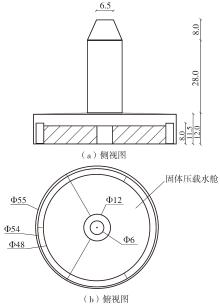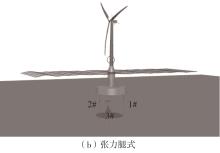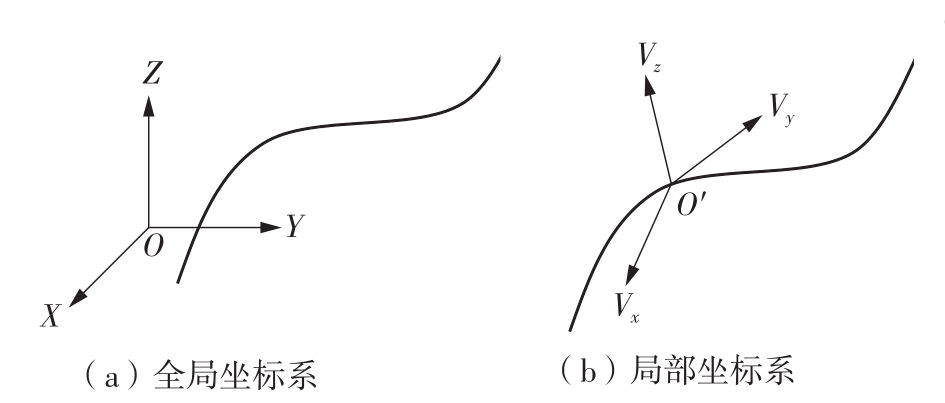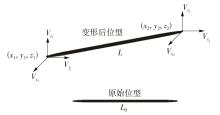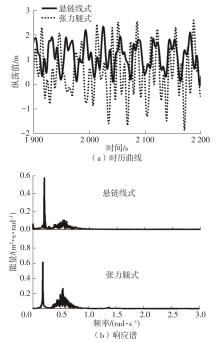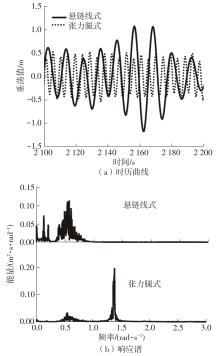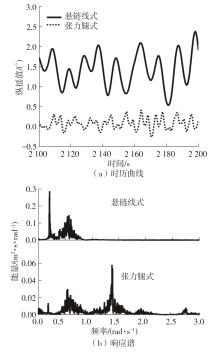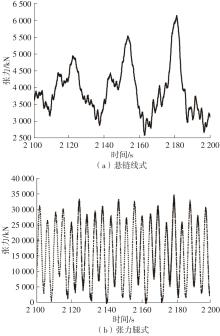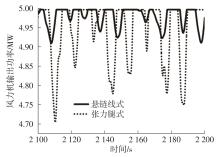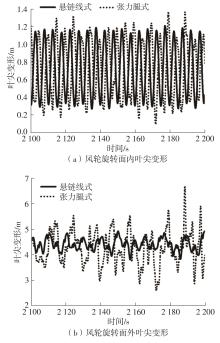Journal of South China University of Technology(Natural Science Edition) ›› 2023, Vol. 51 ›› Issue (8): 80-88.doi: 10.12141/j.issn.1000-565X.220250
Special Issue: 2023年能源、动力与电气工程
• Energy, Power & Electrical Engineering • Previous Articles Next Articles
Study on the Effect of Mooring Form on the Dynamic Response of Floating Offshore Wind Turbine
ZHANG Ruoyu LI Yaolong LI Yan LI Haoran LI Guoyan TANG Yougang
- Tianjin Key Laboratory of Port and Ocean Engineering/State Key Laboratory of Hydraulic Engineering Simulation and Safety/School of Civil Engineering,Tianjin University,Tianjin 300350,China
-
Received:2022-05-04Online:2023-08-25Published:2023-02-03 -
Contact:李焱(1990-),男,博士,副研究员,主要从事海上风电工程及海洋浮体动力响应等研究。 E-mail:liyan_0323@tju.edu.cn -
About author:张若瑜(1981-),女,博士,副教授,主要从事海洋浮式平台及其系泊系统动力响应分析等研究。E-mail:zryu@163.com -
Supported by:the National Natural Science Foundation of China(52001230);China Postdoctoral Science Foundation(2021T140506);the Natural Science Foundation of Tianjin(21JCQNJC00330)
CLC Number:
Cite this article
ZHANG Ruoyu, LI Yaolong, LI Yan, et al. Study on the Effect of Mooring Form on the Dynamic Response of Floating Offshore Wind Turbine[J]. Journal of South China University of Technology(Natural Science Edition), 2023, 51(8): 80-88.
share this article
| 1 | CHEN C, MA Y, FAN T .Review of model experimental methods focusing on aerodynamic simulation of floating offshore wind turbines[J].Renewable and Sustainable Energy Reviews,2022,157:112036/1-13. |
| 2 | JAHANI K, LANGLOIS R G, AFAGH F F .Structural dynamics of offshore wind turbines:A review[J].Ocean Engineering,2022,251:111136/1-17. |
| 3 | 刘利琴,肖昌水,郭颖,等 .基于Jourdain原理和有限元离散的浮式风机动力响应分析[J].哈尔滨工程大学学报,2020,41(3):309-317. |
| LIU Liqin, XIAO Changshui, GUO Ying,et al .Analysis of the dynamic response of a floating wind turbine based on Jourdain principle and a finite element method[J].Journal of Harbin Engineering University,2020,41(3):309-317. | |
| 4 | BAE Y H, KIM M H, KIM H C .Performance changes of a floating offshore wind turbine with broken mooring line[J].Renewable Energy,2017,101:364-375. |
| 5 | BROMMUNDT M, KRAUSE L, MERZ K,et al .Mooring system optimization for floating wind turbines using frequency domain analysis[J].Energy Procedia,2012,24:289-296. |
| 6 | 李焱,唐友刚,朱强,等 .考虑系缆拉伸-弯曲-扭转变形的浮式风力机动力响应研究[J].工程力学,2018,35(12):229-239. |
| LI Yan, TANG Yougang, ZHU Qiang,et al .Study on dynamic response of floating wind turbine based on stretching-bending-torsion coupled nonlinear mooring loads[J].Engineering Mechanics,2018,35(12):229-239. | |
| 7 | 樊天慧,乔东生,欧进萍 .深水悬链锚泊系统等效截断水深优化设计[J].船舶力学,2015,19(5):518-525. |
| FAN Tianhui, QIAO Dongsheng, Jinping OU .Optimized design of deepwater catenary mooring system in equivalent truncated water depth[J].Journal of Ship Mechanics,2015,19(5):518-525. | |
| 8 | 冯丽梅,苏威,闫发锁 .张力腿平台筋腱动力特性分析与校验[J].应用科技,2017,44(4):22-27. |
| FENG Limei, SU Wei, YAN Fasuo .Study on the dynamic characteristics of TLP tendons with verification [J].Applied Science and Technology,2017,44(4):22-27. | |
| 9 | 吴浩宇,赵永生,何炎平,等 .张力腿浮式风机筋腱失效模式下瞬态响应分析[J].浙江大学学报(工学版),2020,54(11):2196-2203. |
| WU Haoyu, ZHAO Yongsheng, HE Yanping,et al .Transient response analysis of tension-leg-platform floating offshore wind turbine under tendon failure conditions [J].Journal of Zhejiang University (Engineering Science),2020,54(11):2196-2203. | |
| 10 | 程阳 .南海TLP风机基础水动力响应研究[D].天津:天津大学,2016. |
| 11 | 张靖晨,李焱,唐友刚,等 .新型浅吃水浮式基础风力机动力响应研究[J].太阳能学报,2021,42(7):378-383. |
| ZHANG Jingchen, LI Yan, TANG Yougang,et al .Analysis on dynamic response of new type reduced draft floating foundation turbine[J].Acta Energiae Solaris Sinica,2021,42(7):378-383. | |
| 12 | 李耀隆,李焱,高靖,等 .新型浅吃水SPAR型浮式风力机断缆情况下动力响应分析[J].振动工程学报,2023,36(3):729-736. |
| LI Yaolong, LI Yan, GAO Jing, al at .Dynamic response analysis of a new-type reduced draft SPAR-type floating offshore wind turbine under fractured mooring line scenarios[J].Journal of Vibration Engineering,2023,36(3):729-736. | |
| 13 | JONKMAN J, BUTTERFIELD S, MUSIAL W,et al .Definition of a 5-MW reference wind turbine for offshore system development[R].[S.l.]:U.S.National Renewable Energy Laboratory (NREL),2009. |
| 14 | 汉森 O L 马丁 .风力机空气动力学[M].肖劲松,译.北京:中国电力出版社,2009. |
| 15 | 郑崇伟,周林.近10年南海波候特征分析及波浪能研究[J].太阳能学报,2012,33(8):1349-1356. |
| ZHENG Chongwei, ZHOU Lin .Wave climate and wave energy analysis of the South China Sea in recent 10 years[J].Acta Energiae Solaris Sinica,2012,33(8):1349-1356. | |
| 16 | 刘铁军,郑崇伟,潘静,等 .中国周边海域海表风场的季节特征、大风频率和极值风速特征分析[J].延边大学学报(自然科学版),2013,39(2):148-152. |
| LIU Tiejun, ZHENG Chongwei, PAN Jing,et al .analysis of seasonal characteristics,gale frequency and extreme wind speed around the China sea[J].Journal of Yanbian University (Natural Science),2013,39(2):148-152. | |
| 17 | 唐友刚,曲晓奇,李焱,等 .畸形波作用下张力腿浮式风力机动力响应特性[J].海洋工程,2021,39(2):1-11. |
| TANG Yougang, QU Xiaoqi, LI Yan,et al .Dynamic response characteristics of TLP type offshore floating wind turbine in freak wave[J].The Ocean Engineering,2021,39(2):1-11. |
| [1] | LI Peizhen, XIAO Jiaqu, YANG Jinping, et al.. Dynamic Response of Frame Structure System Considering SSI Effect [J]. Journal of South China University of Technology(Natural Science Edition), 2023, 51(9): 139-148. |
| [2] | XIAO Ye LUO Xiaoyong. Impact of Increasing Load of Heavy Haul Train on Structural Response of Simply Supported T-shape Beam Bridge [J]. Journal of South China University of Technology (Natural Science Edition), 2020, 48(9): 124-132. |
| [3] |
ZHANG Xiaoqing GAO Huafeng ZHANG Run ZHU Xiaolong HE Min LIU Xiaoming.
Simulation Analysis of Dynamic Response on Fuselage of Carrier-Based Aircraft Arresting Landing
|
| [4] | WEI Wen-hui HUANG Wei-song XUE Guang-wen ZHANG Di. Seismic Response of High-Flexible Structure Under Multi-component Ground Motion [J]. Journal of South China University of Technology (Natural Science Edition), 2017, 45(8): 103-109. |
| [5] | ZANG Meng-yan MENG Ning CHU Shu-min CHEN Yong . Dynamic Response Analysis of a Transmission Housing Under Variable Speed Conditions [J]. Journal of South China University of Technology (Natural Science Edition), 2017, 45(8): 1-6. |
| [6] | ZHANG Xiao-qing DING Tie LONG Shu-chang YAO Xiao-hu. Dynamic response and Damage Prediction of Composite Stiffened Panel Under Hail Impact [J]. Journal of South China University of Technology (Natural Science Edition), 2017, 45(5): 120-128. |
| [7] | SUN Guang-yong ZHANG Jing-tao LI Shi-qiang LI Guang-yao . Dynamic Response Analysis of Hierarchical Aluminum Honeycomb Sandwich Structure Subjected to Explosive Load [J]. Journal of South China University of Technology (Natural Science Edition), 2017, 45(5): 141-146. |
| [8] | DAI Gong-lian LIU Xiang-yu LIU Wen-shuo. Experimental Research on Dynamic Properties of CRTSⅡ Ballastless Track on Simply-Supported Beam [J]. Journal of South China University of Technology (Natural Science Edition), 2017, 45(4): 95-102. |
| [9] | ZHANG Hong DENG Han-guo YAO Xiao-hu LONG Qian. Analysis of Dynamic Responses of Curved Laminated Glass Panels Under Blast Loads [J]. Journal of South China University of Technology (Natural Science Edition), 2016, 44(4): 135-142. |
| [10] | WEI De-min LIU De-yuan LI Di. Nonlinear Response of Reinforced Concrete Frame Structures Under Symmetrical Impact [J]. Journal of South China University of Technology (Natural Science Edition), 2016, 44(2): 8-13. |
| [11] | HE Yan-bin YAO Xiao-hu CHENG Shi-chao LONG Shu-chang ZHANG Xiao-qing. Experimental Investigation into Dynamic Response of Composite Foam Sandwich Plates Under Low-Energy Impact [J]. Journal of South China University of Technology (Natural Science Edition), 2016, 44(10): 57-64,80. |
| [12] | He Zhao-xia Chang Le-hao Liu Lan . Dynamic Response Analysis of Planetary Gear Transmission System Coupled with Gearbox Vibrations [J]. Journal of South China University of Technology (Natural Science Edition), 2015, 43(9): 128-134,148. |
| [13] | Chen Zhou Yan Quan- sheng Hu Jun- liang Huang Shi- ping Yu Xiao- lin. Coupling Vibration Investigation and Parameter Analysis of Crowd- Bridge System [J]. Journal of South China University of Technology (Natural Science Edition), 2014, 42(5): 75-83. |
| [14] | Dong Lei-lei Zhang Qi Huang Yi. Wave-Induced Fatigue Analysis of Deepwater Risers Based on Time-Domain Scaling [J]. Journal of South China University of Technology (Natural Science Edition), 2013, 41(4): 127-131,141. |
| [15] | Luo Su-ping Dan Han-cheng Li Liang Li Ling. Coupled Hydro-Mechanical Analysis of Saturated Asphalt Pavement Under Moving Traffic Loads [J]. Journal of South China University of Technology(Natural Science Edition), 2012, 40(2): 104-111. |
| Viewed | ||||||
|
Full text |
|
|||||
|
Abstract |
|
|||||
